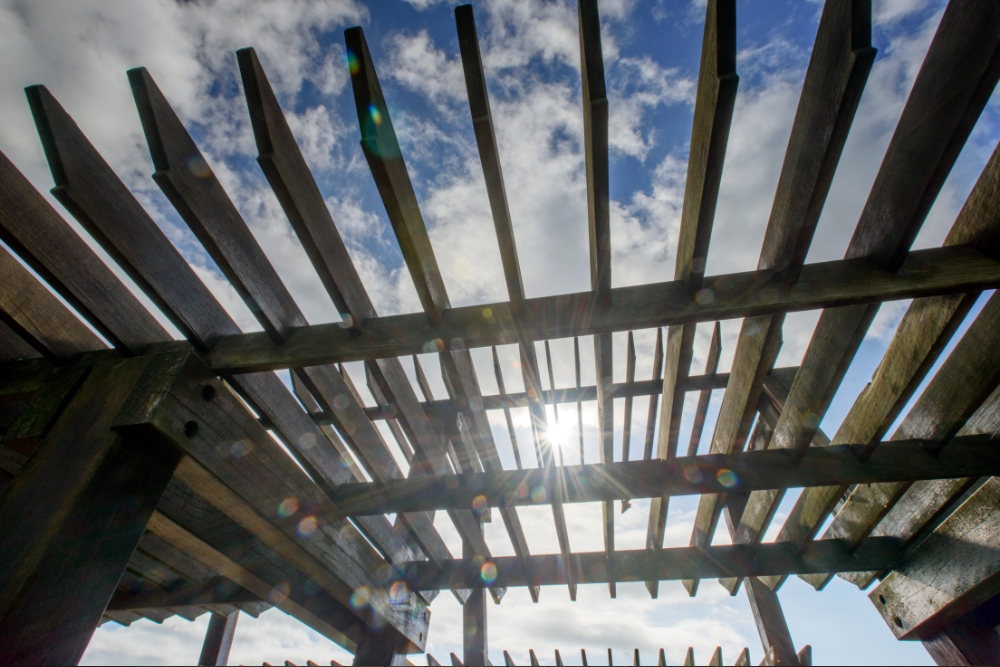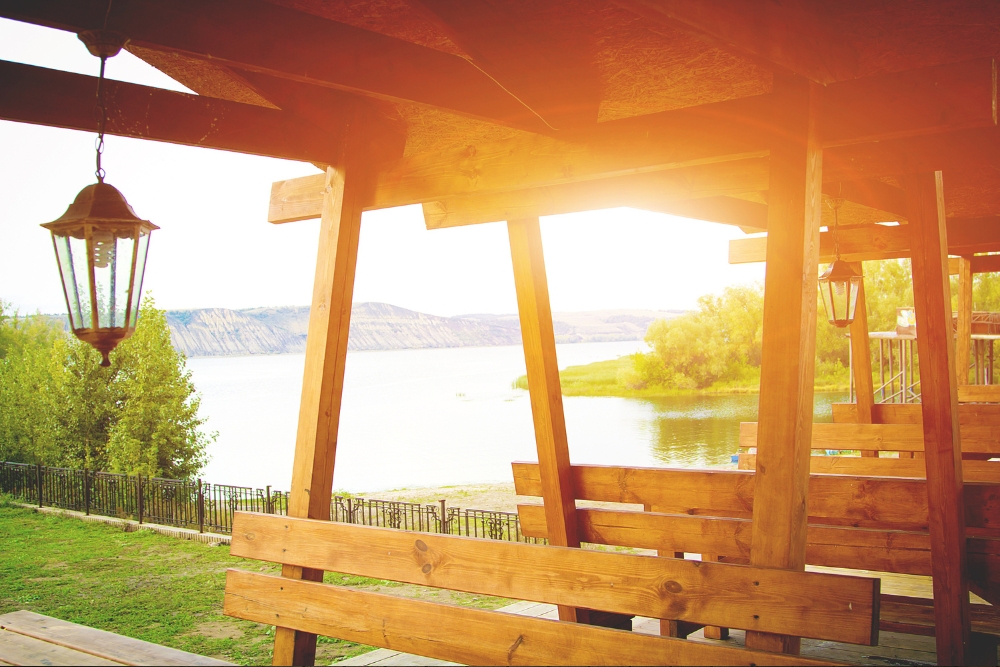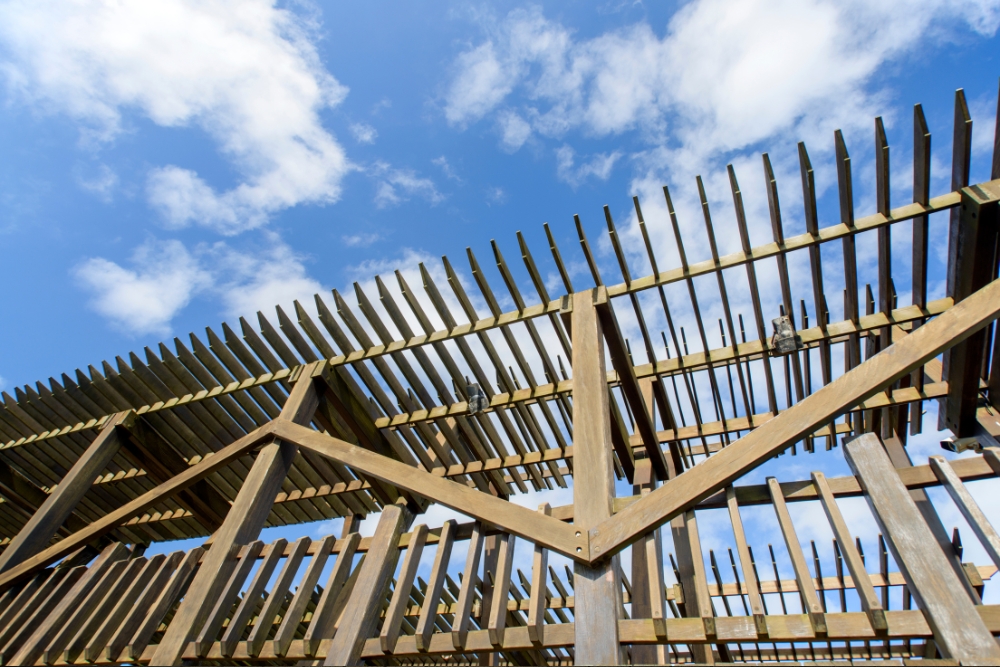We all love a good yarn in the backyard, but let’s face it – battling the Aussie elements to keep our wooden pergolas shipshape can be as tricky as wrestling a croc.
We understand that without giving your timber structure a fair go, its lifetime could cause a serious shortening. So we’ve put together this cracker of a guide brimful with simple steps to make sure your outdoor centrepiece remains sturdy as an old gum tree through sun, rain or howling gales.
So grab yourself a cuppa, have a read and arm yourself with these top-notch tricks for preserving your slice of outdoor paradise!
Key Takeaways
- Wooden pergolas require a coat of sealant or stain every one to two years to fight off sun damage and prevent the wood from warping and fading.
- Frequent inspections for rot, mould, insect activity, and other damage are crucial for maintaining the structural integrity of wooden pergolas.
- High-quality, durable wood is recommended when building a pergola as it withstands environmental challenges better and needs less frequent maintenance.
- Applying waterproof coatings on your wooden pergola helps protect against moisture intrusion that can lead to wood decay or mould growth.
- Customisation options allow homeowners to design their wooden pergolas according to personal preferences while adding features like lighting fixtures enhances functionality and style.

Types of Pergola Material
When it comes to pergola materials, there are a few options to consider. Wooden pergolas offer a natural and traditional look, while vinyl and aluminium pergolas provide low-maintenance alternatives with their durable and weather-resistant properties.
Each material has its own advantages and considerations when it comes to maintenance and protection from the elements.
Wooden Pergolas
We all love the rich, warm look of wooden pergolas in our backyards. They add a charming touch and create a perfect spot for our outdoor gatherings. But we must protect them from sun exposure and harsh weather if we want to keep enjoying their beauty year after year.
The sun’s UV rays can fade and damage the wood, while rain can cause rotting or mould. To prevent this, applying a weather-resistant coating is essential.
Let’s roll up our sleeves regularly to ensure our pergola stands strong against these elements. We’ll start by giving it a thorough clean with water and mild soap—this removes any grime that could wear down the protective layers over time.
Then we check for any signs of damage or insect infestations. Spotting these early means less hassle later on! Next comes sealing the timber with high-quality sealant or stain every one to two years; this step wards off moisture and keeps the wood looking as good as new.
By taking these proactive steps in proper maintenance, we’re not just cleaning—we’re extending the lifespan of our beloved outdoor structures and keeping them pristine for many seasons to come.
Vinyl Pergolas
Vinyl pergolas provide a low-maintenance alternative to wooden structures. They are resistant to rot, mould, and insect damage due to their synthetic composition. Vinyl pergolas also offer excellent weather resistance, making them durable against sun exposure and moisture.
Furthermore, they require minimal upkeep, as they do not need regular sealing or staining like wooden pergolas. These features make vinyl pergolas an attractive option for homeowners seeking a hassle-free outdoor structure that can withstand the elements without extensive maintenance.
When considering outdoor structures such as pergolas, it’s essential to weigh the benefits of different materials. Moving on from vinyl options, aluminium pergolas deserve our attention for their optimal protection against various weather conditions.
Aluminium Pergolas
Aluminium pergolas provide optimal protection against the weather. Unlike wooden pergolas, aluminium ones require minimal maintenance due to their rust-resistant and durable nature.
They are also less susceptible to rot, mould, and insect infestations, making them a low-maintenance option for homeowners. Additionally, their sleek and modern design adds an attractive touch to outdoor spaces.
Applying a sealant or stain every one to two years can protect the wood from weathering and UV damage.
Benefits of Wooden Pergolas
Wooden pergolas offer a natural and aesthetically pleasing addition to outdoor spaces, providing a warm and inviting atmosphere. They are also durable, strong, and highly customisable, making them a popular choice for homeowners looking to enhance their outdoor living areas.
Natural and aesthetically pleasing
Wooden pergolas offer a natural and timeless aesthetic to outdoor spaces. The organic warmth and beauty of wood can complement any garden or backyard design, creating a cosy and inviting atmosphere for relaxation and entertainment.
Properly maintained wooden pergolas retain their original charm, enhancing the overall appeal of the outdoor area while blending seamlessly with nature. The versatility of wood also allows homeowners to customise their pergolas according to personal preferences, adding unique features that reflect individual style.
To protect this natural beauty from deterioration due to weathering elements, it is crucial to invest in regular maintenance that preserves the appearance and structural integrity of wooden pergolas.
Durable and strong
Wooden pergolas are known for their durability and strength, making them an ideal choice for outdoor structures. The natural qualities of wood provide a sturdy and long-lasting framework that can withstand various weather conditions.
Regular maintenance is essential to keep the wooden pergola in top condition, ensuring it remains strong and resilient over time. Applying a protective sealant or stain every one to two years can shield the wood from UV damage, preventing warping and cracks while extending its lifespan.
It’s important to choose high-quality wood for the pergola construction as this contributes significantly to its robustness and ability to weather the elements effectively.
Ensuring proper care for a wooden pergola not only maintains its structural integrity but also preserves its aesthetic appeal. Treating the timber with protective coatings strengthens its resistance against moisture damage, reducing the risk of rot or mould.
Customisable
When it comes to pergolas, the ability to customise your wooden structure is a significant advantage. You can tailor the design and size of your wooden pergola to fit perfectly with your outdoor space, enhancing its visual appeal and functionality.
From choosing the type of wood to selecting specific design elements such as lattice panels or decorative ends, homeowners have the freedom to create a unique and personalised look for their wooden pergola.
Additionally, you can further customise your pergola by adding accessories like lighting fixtures or hanging plants, making it an inviting and comfortable outdoor living space that reflects your personal style and preferences.
Environmental Factors That Can Damage Wooden Pergolas
Sun exposure, moisture damage, and insect infestations can all contribute to the deterioration of wooden pergolas. To learn more about how to protect your outdoor wooden structures from these elements, keep reading.
Sun exposure
Prolonged sun exposure can cause the wood of a pergola to fade, dry out, and become brittle over time. UV rays from the sun can break down the natural oils in the wood, leading to premature weathering and cracking.

Applying a sealant or stain every one to two years can protect the wood from weathering and UV damage. It’s important to ensure that the wood is coated with a sealant to prevent warps and cracks.
Sealants are available in many varieties to suit different types of wood and weather conditions. Proper maintenance and care can help extend the longevity of a wooden pergola, even when exposed to direct sunlight.
Moisture damage
Moisture can wreak havoc on wooden pergolas, leading to rot, mould, and structural damage. Without proper protection, excess moisture from rain or humidity can seep into the wood, causing it to swell and eventually weaken over time.
This makes regular maintenance crucial in preventing moisture damage. Applying a waterproof sealant every one to two years can provide a protective barrier against water intrusion.
Additionally, ensuring that any cracks or chips are promptly sealed with an appropriate paint or sealant will prevent further moisture penetration.
Insect infestations
Insect infestations can pose a significant threat to the integrity of wooden pergolas. Termites, carpenter ants, and other wood-boring insects can cause extensive damage to the structure over time if left unchecked.
To protect against insect infestations, it’s essential to inspect the pergola regularly for any signs of pest activity. Consider treating the wood with appropriate insecticides or repellents as a proactive measure to deter these pests from making your pergola their home.
Applying a protective coating such as sealant or stain not only safeguards the wood from weathering but also creates an additional barrier against invasive insects. Regular maintenance and care are crucial in preventing insect infestations and preserving the structural integrity of your wooden pergola.

Proper Maintenance for Wooden Pergolas
To ensure the longevity of your wooden pergola, regular cleaning and sealing are essential. It’s also important to inspect for any signs of damage and treat the wood with protective coatings to safeguard against environmental factors.
Regular cleaning and sealing
To keep a wooden pergola in top condition, regular cleaning and sealing are essential. Here’s how to maintain the integrity of your outdoor structure:
- Clean the pergola with a mixture of water and mild soap to remove debris and dirt, enhancing its appearance and durability.
- Inspect for any signs of damage such as cracks or warping, addressing them promptly to prevent further deterioration.
- Apply a fresh coat of sealant or stain every one to two years to protect the wood from weathering, UV damage, discolouration, and fading.
- Opt for sealants specifically designed for different types of wood and varying weather conditions to ensure optimal protection.
Inspecting for damage
Inspecting for damage is vital to maintaining a wooden pergola. Regularly check for any signs of rot, mould, or insect infestations.
- Look for any soft spots or areas that seem darker than the rest of the wood as these can indicate rot.
- Check for any visible signs of mould or mildew on the surface of the wood.
- Examine the structure closely for any holes or tunnels that may indicate an insect infestation.
- Pay attention to any warping or cracking in the wood, as these can be signs of weather damage.
- Ensure there are no loose or damaged components such as screws, nails, or fasteners holding the pergola together.
- Inspect the base of the pergola to make sure it is not in contact with damp soil, which can lead to moisture damage over time.
Treating with protective coatings
To protect your wooden pergola from the elements, it’s essential to treat it with protective coatings. Here’s how to ensure your wooden pergola stays in top condition:
- Sealants are available in various types tailored for different wood and weather conditions. Choosing the right sealant is crucial for effective protection against UV damage and weathering.
- Apply a fresh coat of sealant or stain every one to two years to maintain the wood’s integrity. This routine application helps prevent warping, cracking, and fading caused by sun exposure.
- Regularly inspect for signs of wear and tear, such as discolouration or moisture damage, before applying protective coatings. Prompt maintenance can help maintain the aesthetic appeal while preventing long-term damage.
- Waterproofing timber with a quality sealant not only extends the lifespan of your wooden pergola but also safeguards it against rot and mould, common threats in outdoor environments.
- Properly sealing and waterproofing your pergola also helps in preserving its natural beauty, effectively preventing discolouration and maintaining its original charm.
- Prioritise weather protection when choosing a protective coating – this not only keeps your pergola looking great but also ensures its structural durability over time.
- Always use wood sealants and stains specifically designed for outdoor use; these products are formulated to withstand harsh environmental conditions and provide optimal protection for outdoor wooden structures.
- By following these maintenance tips for treating with protective coatings, you can significantly extend the longevity of your wooden pergola while keeping it looking beautiful year after year.
Transform Your Space’s Appeal with Aluminum Pergolas!
In conclusion, maintaining a wooden pergola is essential to protect it from environmental damage. Regular cleaning and sealing can help prevent moisture damage and insect infestations.
Proper maintenance not only extends the lifespan of your pergola but also preserves its natural beauty for years to come. With the right care, you can enjoy your wooden pergola as a durable and aesthetically pleasing outdoor structure.
Shield your outdoor oasis from the elements! Ensure the longevity and beauty of your wooden pergolas with proper maintenance. Our expert tips and high-quality products offer the ultimate protection against weathering. Don’t let nature take its toll – take charge of your outdoor space today. Explore our maintenance solutions and fortify your wooden pergolas for years of enjoyment. Weatherproof your paradise now! Contact Now!




